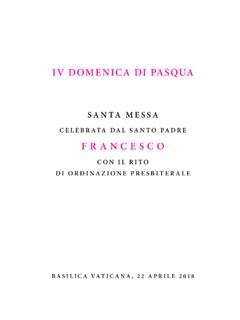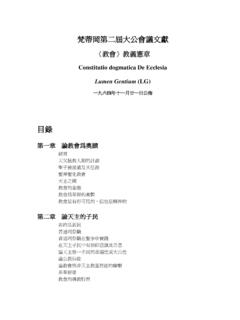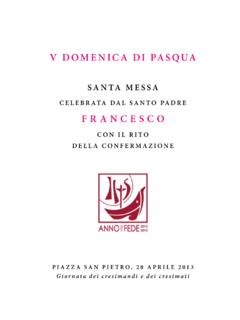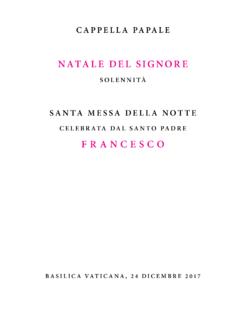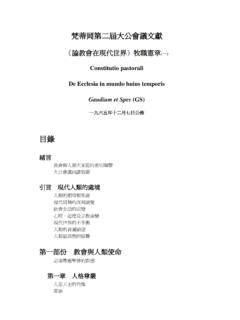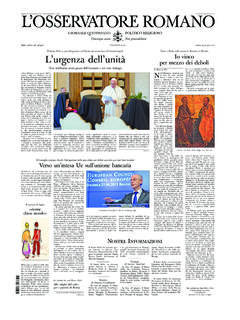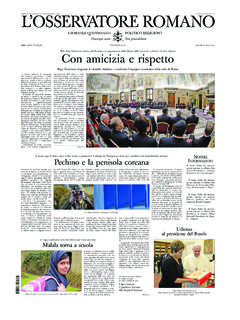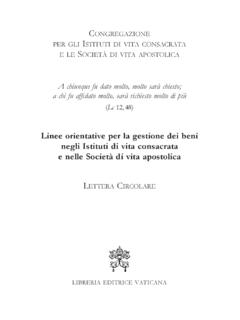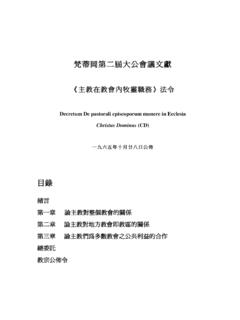Transcription of FRANCIS APOSTOLIC CONSTITUTION - Vatican
1 FRANCISAPOSTOLIC CONSTITUTIONVULTUM DEI QUAEREREON WOMEN S CONTEMPLATIVE LIFE31. Seeking the face of god has always been a part of our human history. From the beginning, men and women have been called to a dialogue of love with the Indeed, mankind is distin-guished by an irrepressible religious dimension that leads human hearts to feel the need albeit not always consciously to seek God, the Absolute. This quest unites all men and women of good will. Even many who claim to be non-believers acknowledge this heartfelt longing, present in all men and women who, drawn by a passionate desire for happiness and fulfilment, never remain fully satisfied. Saint Augustine eloquently expressed this yearning in the Con-fessions: You made us for yourself, and our hearts are restless until they find their rest in you .2 This restlessness of heart is born of the profound intuition that it is God himself who takes the initia-tive; he seeks out men and women and mysteriously draws them to seeking God, we quickly realize that no one is self-sufficient.
2 Rather, we are called, in the light of faith, to move beyond self-cen-tredness, drawn by God s Holy Face and by the sacred ground of the other ,3 to an ever more profound experience of Baptism, every Christian and every consecrated per-son is called to undertake this pilgrimage of seeking the true God. By the working of the Holy Spirit, it becomes a sequela pressius Christi a path of ever greater configuration to Christ the Lord. 1 Cf. Second Vatican ecumenical council, Pastoral CONSTITUTION Gaudium et Spes, I, 1, 1: PL 32, Cf. APOSTOLIC exhortation Evangelii Gaudium (24 November 2013), 169: AAS 105 (2013), path finds notable expression in religious consecration and, in a particular way, in the monastic life, which, from its origins, was seen as a specific way of living out one s baptism. 2. Consecrated persons, by virtue of their consecration, follow the Lord in a special way, in a prophetic way.
3 4 They are called to recognize the signs of God s presence in daily life and wisely to discern the questions posed to us by God and the men and women of our time. The great challenge faced by consecrated persons is to persevere in seeking God with the eyes of faith in a world which ignores his presence ,5 and to continue to offer that world Christ s life of chastity, poverty and obedience as a credible and trustworthy sign, thus becoming a living exegesis of God s word .6 From the origins of the life of special consecration in the Church, men and women called by God and in love with him have devoted their lives exclusively to seeking his face, longing to find and contem-plate God in the heart of the world. The presence of communities set like cities on a hill or lamps on a stand (Mt 5:14-15), despite their simplicity of life, visibly represent the goal towards which the entire ecclesial community journeys.
4 For the Church advances down the paths of time with her eyes fixed on the future restor-ation of all things in Christ,7 thus announcing in advance the glory of heaven .83. Peter s words, Lord, it is good for us to be here! (Mt 17: 4), have a special meaning for all consecrated persons. This is particu-4 APOSTOLIC Letter to All Consecrated Persons for the Year of Consecrated Life (21 November 2014), II, 2: AAS 106 (2014), John Paul ii, Post-Synodal APOSTOLIC exhortation Vita Consecrata (25 March 1996), 68: AAS 88 (1996), 443. 6 Benedict XVi, Post-Synodal APOSTOLIC exhortation Verbum Domini (30 Sep-tember 2010), 83: AAS 102 (2010), John Paul ii, Post-Synodal APOSTOLIC exhortation Vita Consecrata (25 March 1996), 59: AAS 88 (1996), Cf. Code of Canon Law, can. 573 1. 5larly the case for contemplatives. In profound communion with every other vocation of the Christian life all of which are like so many rays of the one light of Christ, whose radiance brightens the countenance of the Church 9 contemplatives devote a great part of their day imitating the Mother of God, who diligently pon-dered the words and deeds of her Son (cf.)
5 Lk 2 ), and Mary of Bethany, who sat at the Lord s feet and listened attentively to his words (cf. Lk 10:38) .10 Their lives, hidden with Christ in God (cf. Col 3:3), become an image of the unconditional love of the Lord, himself the first contemplative. They are so centred on Christ that they can say with the Apostle. For to me, to live is Christ! (Phil 1:21). In this way, they express the all-encompassing charac-ter at the heart of a vocation to the contemplative Contemplatives, as men and women immersed in human his- tory and drawn to the splendour of Christ, the fairest of the sons of men (Ps 45:3), are set in the heart of the Church and the In their unending search for God, they discover the principal sign and criterion of the authenticity of their consecrated life. Saint Benedict, the father of Western monasticism, emphasized that a monk is one whose entire life is devoted to seeking God.
6 He in-sisted that it be determined of one aspiring to the monastic life si revera Deum quaerit , whether he truly seeks a particular way, down the centuries countless consecrated women have devoted, and continue to devote the whole of their 9 Ibid., 16: AAS 88 (1996), 389. 10 Benedict XVi, Post-Synodal APOSTOLIC exhortation Verbum Domini (30 Sep-tember 2010), 83: AAS 102 (2010), Cf. John Paul ii, Post-Synodal APOSTOLIC exhortation Vita Consecrata (25 March 1996), 18: AAS 88 (1996), 391-392. 12 Cf. Second Vatican ecumenical council, Dogmatic CONSTITUTION Lumen Gentium, 44; John Paul II, Post-Synodal APOSTOLIC exhortation Vita Consecrata (25 March 1996), 3 and 29: AAS 88 (1996), 379, Rule 58, and all their activities to the contemplation of God ,14 as a sign and prophecy of the Church, virgin, spouse and mother. Their lives are a living sign and witness of the fidelity with which God, amid the events of history, continues to sustain his The monastic life, as an element of unity with the other Chris-tian confessions,15 takes on a specific form that is prophecy and sign, one that can and ought to attract all the members of the Church to an effective and prompt fulfilment of the duties of their Christian vocation.
7 16 Communities of prayer, especially contemplative com-munities, which by virtue of their separation from the world are all the more closely united to Christ, the heart of the world ,17 do not propose a more perfect fulfilment of the Gospel. Rather, by living out the demands of Baptism, they constitute an instance of discern-ment and a summons to the service of the whole Church. Indeed, they are a signpost pointing to a journey and quest, a reminder to the entire People of God of the primary and ultimate meaning of the Christian , PraiSe and thankSgiVing for conSecrated life and cloiStered contemPlatiVe life5. From the earliest centuries the Church has shown great esteem and sincere love for those men and women who, in docility to the Father s call and the promptings of the Spirit, have chosen to follow 14 John Paul ii, Post-Synodal APOSTOLIC exhortation Vita Consecrata (25 March 1996), 8: AAS 88 (1996), id.
8 , APOSTOLIC Letter Orientale Lumen (2 May 1995), 9: AAS 87 (1995), Second Vatican ecumenical council, Dogmatic CONSTITUTION Lumen Gentium, 44, Benedict XVi, Post-Synodal APOSTOLIC exhortation Verbum Domini (30 Sep-tember 2010), 83: AAS 102 (2010), Cf. Second Vatican ecumenical council, Decree Perfectae Caritatis, 5. 7 Christ more closely ,19 dedicating themselves to him with an undiv- ided heart (cf. 1 Cor 7:34). Moved by unconditional love for Christ and all humanity, particularly the poor and the suffering, they are called to reproduce in a variety of forms as consecrated virgins, widows, hermits, monks and religious the earthly life of Jesus in chastity, poverty and contemplative monastic life, made up mainly of women, is rooted in the silence of the cloister; it produces a rich harvest of grace and mercy. Women s contemplative life has always rep-resented in the Church, and for the Church, her praying heart, a storehouse of grace and APOSTOLIC fruitfulness, and a visible witness to the mystery and rich variety of Originating in the individual experience of virgins consecrated to Christ, the natural fruit of a need to respond with love to the love of Christ the Bridegroom, this life soon took form as a definite state and an order recognized by the Church, which began to re-ceive public professions of virginity.
9 With the passage of time, most consecrated virgins united in forms of common life that the Church was concerned to protect and preserve with a suitable discipline. The cloister was meant to preserve the spirit and the strictly con-templative aim of these houses. The gradual interplay between the working of the Spirit, present in the heart of believers and inspir-ing new forms of discipleship, and the maternal solicitude of the Church, gave rise to the forms of contemplative and wholly contem-plative life that we know In the West, the contemplative spirit found expression in a multiplicity of charisms, whereas in the 19 Ibid., Cf. John Paul II, Post-Synodal APOSTOLIC exhortation Vita Consecrata (25 March 1996), 14: AAS 88 (1996), Cf. Second Vatican ecumenical council, Dogmatic CONSTITUTION Lumen Gentium, 46; Decree Christus Dominus, 35; Decree Perfectae Caritatis, 7 and 9; Code of Canon Law, can.
10 674. 22 Cf. Code of Canon Law, can. 667 it maintained great unity,23 but always as a testimony to the richness and beauty of a life devoted completely to God. Over the centuries, the experience of these sisters, centred on the Lord as their first and only love (cf. Hos 2:21-25), has brought forth abundant fruits of holiness and mission. How much has the apostolate been enriched by the prayers and sacrifices radiating from monasteries! And how great is the joy and prophecy pro-claimed to the world by the silence of the cloister!For the fruits of holiness and grace that the Lord has always bestowed through women s monastic life, let us sing to the Most High, the Almighty and good Lord the hymn of thanksgiving Laudato si ! 24 6. Dear contemplative sisters, without you what would the Church be like, or without all those others living on the fringes of human-ity and ministering in the outposts of evangelization?
